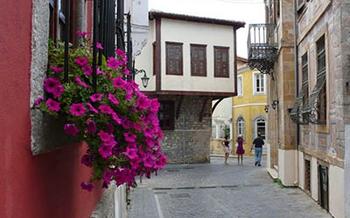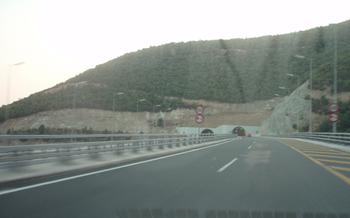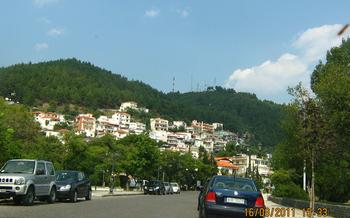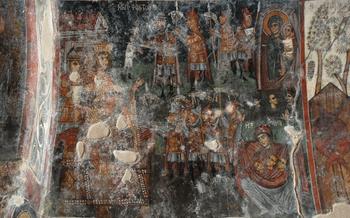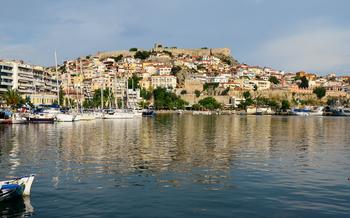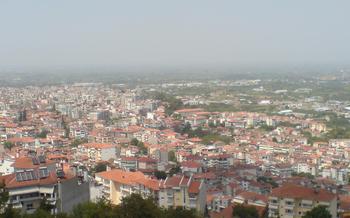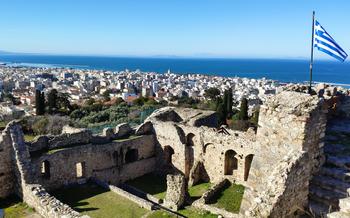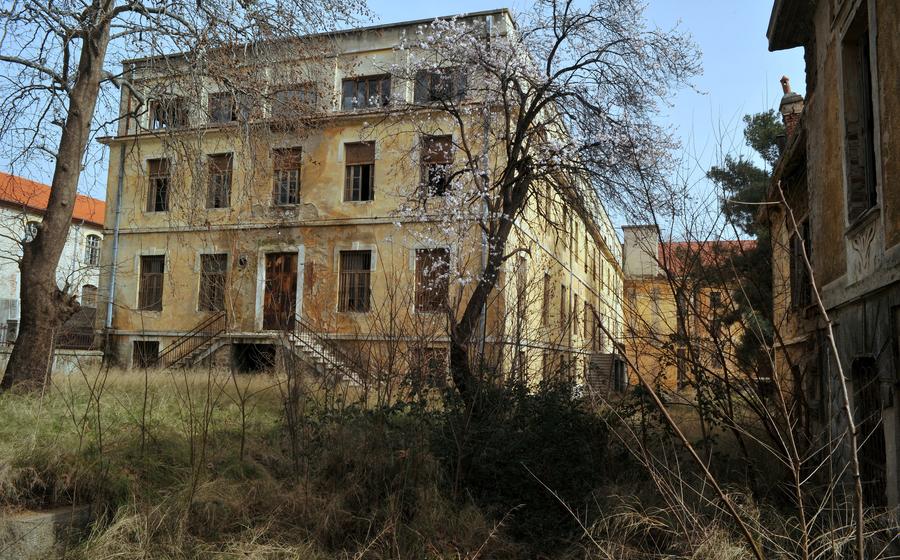
The Holy Monastery of Panagia Kalamous
- The Holy Monastery of Panagia Kalamous: A Historical Overview
- Captivating Murals and Frescoes: Inside the Monastery's Sacred Art
- A Haven of Tranquility: The Monastery's Serene Surroundings
- Worship and Devotion: Exploring the Monastery's Religious Practices
- Religious Festivals and Celebrations: A Time for Joy and Unity
- Pilgrimage to the Monastery: A Journey of Faith and Renewal
- Monastic Life: Unveiling the Daily Routine of the Monks
- The Hegumen: A Guiding Force in the Monastery's Community
- Monastic Treasures: Discovering the Monastery's Artifacts
- The Role of Women: Exploring the Contribution of Nuns
- A Living Heritage: The Monastery's Ongoing Significance
- The Monastery's Contribution to the Local Economy
- Supporting the Monastery: Ways to Contribute and Get Involved
- Visitor Information: Planning Your Visit to the Monastery
- Insider Tip: Exploring the Hidden Gems of the Region
The Holy Monastery of Panagia Kalamous: A Historical Overview
Nestled amidst the picturesque landscapes of Xanthi, Greece, lies the Holy Monastery of Panagia Kalamous, a sanctuary steeped in history and religious significance. Its origins can be traced back to the Byzantine era, when it was established as a humble chapel dedicated to the Virgin Mary. Over the centuries, the monastery underwent several renovations and expansions, transforming into the awe-inspiring complex that stands today.
The architectural style of the monastery reflects the Byzantine and post-Byzantine influences prevalent in the region. Its striking whitewashed walls, intricate stone carvings, and graceful arches create a harmonious blend of architectural elements. The main church, adorned with a magnificent dome, serves as the spiritual heart of the monastery, inviting pilgrims and visitors to immerse themselves in its sacred atmosphere.
As a prominent center of Greek Orthodox Christianity, the Holy Monastery of Panagia Kalamous holds a revered position among the faithful. It has been a site of worship, pilgrimage, and spiritual renewal for centuries, attracting devout believers from across Greece and beyond. The monastery's enduring legacy and spiritual significance continue to inspire and captivate visitors, making it a cherished destination for those seeking solace, connection, and a deeper understanding of their faith.
Captivating Murals and Frescoes: Inside the Monastery's Sacred Art
Stepping inside the Holy Monastery of Panagia Kalamous is like entering a sacred art gallery. The walls and ceilings are adorned with exquisite murals and frescoes, each a testament to the skill and devotion of the anonymous artists who created them. These stunning artworks depict scenes from the Bible, the lives of saints, and the history of the monastery itself, bringing to life the stories and teachings of the Orthodox faith.
The murals and frescoes are not mere decorations; they serve as a powerful means of religious instruction and inspiration. Through their vibrant colors and intricate details, they convey deep theological truths, moral lessons, and spiritual insights. They invite the faithful to contemplate the mysteries of faith, to connect with the divine, and to find solace and guidance in their spiritual journey.
The artistic techniques employed in the monastery's murals and frescoes are remarkable. The use of tempera, a traditional medium made from egg yolk and pigments, creates a luminous and vibrant effect. The artists' mastery of perspective and composition results in lifelike figures and scenes that seem to leap off the walls. The delicate brushstrokes and attention to detail reveal the artists' deep love and respect for their craft.
These sacred artworks are not only aesthetically pleasing but also deeply meaningful. They are a testament to the rich artistic heritage of the Greek Orthodox Church and a source of inspiration and devotion for generations of pilgrims and visitors.
A Haven of Tranquility: The Monastery's Serene Surroundings
Nestled amidst the breathtaking natural beauty of Xanthi, the Holy Monastery of Panagia Kalamous provides a sanctuary of serenity for visitors seeking solace and spiritual rejuvenation. As you step onto the monastery grounds, you're greeted by a symphony of colors, sounds, and scents that evoke a sense of tranquility. Lush greenery envelops the monastery, with towering cypress trees standing guard, their branches swaying gently in the breeze. The air is filled with the sweet fragrance of blooming flowers and the melodious chirping of birds, creating a harmonious chorus that calms the soul.
Strolling through the monastery's serene courtyard, you'll notice the meticulous attention to detail in the landscaping. Well-manicured gardens, adorned with vibrant blooms and cascading vines, add to the enchanting ambiance. The courtyard is dotted with shaded benches, inviting visitors to pause and soak in the tranquility of the surroundings. From these vantage points, you can admire the stunning views of the surrounding landscape, where rolling hills and verdant valleys stretch as far as the eye can see.
The monastery's peaceful atmosphere is conducive to reflection and introspection. As you wander through the serene grounds, you'll find yourself drawn to quiet contemplation, allowing your mind to wander freely and connect with your inner self. The monastery's tranquil environment provides a sanctuary for those seeking respite from the hustle and bustle of modern life, offering an opportunity to reconnect with nature, spirituality, and the simple joys of life.
Worship and Devotion: Exploring the Monastery's Religious Practices
The Holy Monastery of Panagia Kalamous is a sanctuary for worship and devotion, where the monks and pilgrims engage in a variety of religious practices that deepen their connection with the divine. Daily services and rituals, such as the Divine Liturgy, Vespers, and Matins, form the cornerstone of the monastery's spiritual life. These services, conducted in the ancient Byzantine tradition, are a testament to the rich liturgical heritage of the Greek Orthodox Church.
Prayer and contemplation are central to the monastic experience. The monks and pilgrims retreat to the monastery's serene surroundings to immerse themselves in deep meditation and communion with God. The monastery's tranquil atmosphere, free from worldly distractions, provides the perfect setting for spiritual growth and self-reflection.
Visitors to the monastery have the opportunity to engage with the resident monks, who are always willing to share their knowledge of Orthodox theology and spirituality. Whether through informal conversations or organized retreats, the monks offer guidance and wisdom to those seeking a deeper understanding of the Christian faith.
Religious Festivals and Celebrations: A Time for Joy and Unity
The Holy Monastery of Panagia Kalamous becomes a vibrant center of religious festivities and celebrations throughout the year. These events bring together the local community, pilgrims, and visitors, creating a harmonious atmosphere of joy and unity. The most significant festival is the feast of the Assumption of the Virgin Mary, held on August 15th, which attracts thousands of devotees. During the festival, the monastery hosts solemn processions, special liturgies, and traditional dances, allowing participants to immerse themselves in the rich spiritual and cultural traditions of the region.
Other notable festivals include Easter, Christmas, and the feast of Saint George. Each celebration has its unique rituals and customs, showcasing the deep religious devotion and cultural heritage of the monastery and the surrounding area. Participating in these festivals offers visitors a profound insight into the spiritual essence of the monastery and the vibrant faith of the local people.
Pilgrimage to the Monastery: A Journey of Faith and Renewal
The Holy Monastery of Panagia Kalamous has long been a significant pilgrimage site for devoted Greek Orthodox Christians. Pilgrims from all corners of Greece and beyond flock to this sacred place, drawn by its reputation for spirituality, tranquility, and the opportunity to deepen their connection with their faith.
For many pilgrims, the journey to the monastery is a transformative experience. The serene atmosphere, coupled with the powerful energy of the monastery's holy grounds, creates an environment conducive to reflection, introspection, and spiritual renewal. Pilgrims often embark on this journey seeking solace, guidance, or a renewed sense of purpose in their lives.
The act of pilgrimage itself holds deep significance in the Orthodox tradition. It symbolizes a physical and spiritual journey, a quest to draw closer to God through the intercession of the Virgin Mary and the saints associated with the monastery. Pilgrims often engage in various devotional practices during their visit, such as lighting candles, praying before icons, and participating in the divine services.
The monastery's resident monks play a crucial role in facilitating the pilgrims' spiritual experiences. They offer guidance, support, and encouragement to those seeking spiritual growth and renewal. Pilgrims often engage in conversations with the monks, seeking their wisdom, blessings, and prayers.
The pilgrimage to the Holy Monastery of Panagia Kalamous is not merely a religious journey; it is a deeply personal and transformative experience that leaves a lasting impact on the hearts and souls of those who undertake it.
Monastic Life: Unveiling the Daily Routine of the Monks
Within the walls of the Holy Monastery of Panagia Kalamous, a structured and dedicated daily routine defines the lives of the resident monks. Their days begin at the break of dawn, marked by the melodious sound of the monastery bell calling them to morning prayers. Gathered in the sacred chapel, they chant hymns and recite psalms, immersing themselves in spiritual communion with the divine.
After prayers, the monks engage in various tasks and chores to sustain the monastery's functioning. They tend to the gardens, vineyards, and orchards, nurturing the land with their labor. Others may be found in the kitchen, preparing simple yet nutritious meals for the monastic community. Some monks devote their time to preserving the monastery's rich collection of manuscripts and artifacts, ensuring their preservation for future generations.
As the sun reaches its peak, the monks gather for their midday meal, a time for fellowship and reflection. They share stories, discuss religious texts, and engage in thought-provoking conversations that deepen their spiritual understanding.
The afternoon hours are dedicated to personal prayer and contemplation. Each monk retreats to his cell, a humble abode that provides a sanctuary for introspection and connection with the divine. Through meditation and study, they seek enlightenment and strive to strengthen their relationship with God.
As the day draws to a close, the monks reconvene for evening prayers, offering gratitude for the blessings bestowed upon them. The monastery falls into a tranquil silence, as the monks retire to their cells to rest and prepare for the cycle to begin anew the following day.
The Hegumen: A Guiding Force in the Monastery's Community
At the helm of the Holy Monastery of Panagia Kalamous, a figure of great reverence and authority resides: the hegumen, also known as the abbot. This esteemed individual holds the responsibility of guiding and overseeing the spiritual and administrative affairs of the monastery, ensuring its smooth functioning and the well-being of its monastic community.
Chosen for their wisdom, piety, and leadership qualities, the hegumen serves as the spiritual father to the monks, providing guidance, counsel, and support. They lead the daily prayers and rituals, ensuring the adherence to the monastic rules and traditions. Through their teachings and example, they inspire the monks to strive for spiritual growth and enlightenment.
In addition to their spiritual duties, the hegumen also manages the monastery's temporal affairs. They oversee the financial resources, supervise the maintenance and upkeep of the monastery's buildings and grounds, and coordinate the various activities and projects undertaken by the monastic community. Their administrative skills and prudence ensure the monastery's stability and sustainability.
The hegumen's role extends beyond the monastery walls, as they actively engage with the local community, fostering relationships of cooperation and support. They represent the monastery at religious and cultural events, promoting its mission and values, and contributing to the overall well-being of the region.
Through their dedication, wisdom, and compassionate leadership, the hegumen plays a vital role in preserving the rich spiritual heritage of the Holy Monastery of Panagia Kalamous and guiding its community towards a life of devotion, service, and spiritual fulfillment.
Monastic Treasures: Discovering the Monastery's Artifacts
Embedded within the hallowed walls of the Holy Monastery of Panagia Kalamous, a treasure trove of sacred artifacts and relics awaits discovery. Ancient icons, adorned with shimmering gold leaf and vibrant hues, depict scenes from the Bible and the lives of saints, captivating the hearts of visitors with their intricate details and poignant expressions. These icons, meticulously crafted by skilled artisans, serve as windows into the monastery's rich history and the deep faith that has permeated its walls for centuries.
Among the monastery's prized possessions are exquisitely preserved religious relics, tangible remnants of a bygone era. These relics, often associated with saints or significant religious figures, exude an aura of reverence and spirituality. They are carefully displayed within the monastery's sanctuary, inviting pilgrims and visitors to contemplate the profound impact of these sacred objects on the lives of the faithful.
In addition to these religious treasures, the monastery houses a collection of historical documents and manuscripts that chronicle the institution's storied past. These documents, meticulously penned in elegant calligraphy, provide valuable insights into the daily life, customs, and traditions of the monastery's inhabitants throughout the ages. They offer a glimpse into the challenges and triumphs that have shaped the monastery's enduring legacy.
Preserving and showcasing these artifacts is a testament to the monastery's commitment to safeguarding its rich heritage. By curating and displaying these treasures, the monks ensure that the monastery's unique story and profound spiritual significance are passed down to future generations, inspiring awe and devotion in the hearts of all who behold them.
The Role of Women: Exploring the Contribution of Nuns
The Holy Monastery of Panagia Kalamous is not only a sanctuary for monks but also a place where nuns play a vital role. These dedicated women contribute significantly to the monastery's operations and the well-being of the monastic community.
Nuns in the monastery lead a life of devotion and service. They participate in daily prayers and rituals, adhering to the same spiritual disciplines as the monks. Additionally, they undertake various practical tasks essential for the smooth functioning of the monastery.
One of the most important roles of the nuns is their involvement in the preservation and maintenance of the monastery's rich heritage. They carefully care for ancient icons, religious relics, and historical documents, ensuring that these treasures are preserved for future generations.
Beyond their contributions within the monastery walls, the nuns also extend their support to the local community. They actively engage in charitable work, providing assistance to those in need and participating in community events. Their presence and service are highly valued by the local population, who deeply appreciate their contributions.
The nuns' presence in the monastery creates a unique and harmonious atmosphere. Their dedication, compassion, and unwavering faith add to the spiritual depth and richness of the monastic community. Their presence serves as a reminder that the monastery is not just a place of worship but also a place where women can find fulfillment and purpose through a life of devotion and service.
A Living Heritage: The Monastery's Ongoing Significance
The Holy Monastery of Panagia Kalamous is not merely a place of worship but a living heritage that embodies the rich cultural traditions of Greece. Its enduring presence over centuries has left an indelible mark on the region's history and identity. The monastery has been a steadfast guardian of Greek Orthodox Christianity, preserving ancient customs and rituals that have been passed down through generations.
The monastery's architectural grandeur and stunning frescoes are a testament to the artistry and craftsmanship of Byzantine times. Visitors are awestruck by the intricate details and vibrant colors that adorn the walls and ceilings, telling stories of faith, devotion, and the lives of saints. The monastery also houses a collection of ancient icons, religious relics, and historical documents that provide a glimpse into the monastery's rich past.
Beyond its religious significance, the monastery has played a vital role in the local economy, providing employment opportunities for the surrounding community. Local businesses and services thrive thanks to the influx of pilgrims and visitors who come to explore the monastery's sacred grounds. The monastery also generates revenue through tourism, contributing to the economic development of the region.
The Holy Monastery of Panagia Kalamous stands as a symbol of resilience and continuity, having weathered centuries of change and adversity. It has adapted to the evolving needs of the community while remaining true to its core principles of faith, devotion, and service. Its ongoing significance as a spiritual and cultural landmark ensures that its legacy will continue to inspire future generations.
The Monastery's Contribution to the Local Economy
The Holy Monastery of Panagia Kalamous plays a significant role in supporting the local economy of Xanthi. It provides employment opportunities for the local population, contributing to the region's economic growth and development. Many individuals find employment within the monastery, fulfilling various roles such as maintenance, hospitality, and administrative tasks.
The monastery's presence also stimulates the local economy by attracting a steady stream of visitors and pilgrims. These visitors often seek accommodation, dining, and other services in the surrounding area. This increased demand for goods and services benefits local businesses, creating a positive ripple effect throughout the community.
In addition, the monastery's status as a popular tourist destination generates revenue through tourism. Visitors often purchase souvenirs, traditional crafts, and local products from the monastery's gift shop, contributing to the monastery's financial sustainability. These funds are then reinvested into the maintenance and upkeep of the monastery, ensuring its preservation and continued operation.
Supporting the Monastery: Ways to Contribute and Get Involved
The Holy Monastery of Panagia Kalamous welcomes support from visitors and pilgrims who wish to contribute to its preservation and ongoing operations. Here are several ways you can get involved and make a meaningful difference:
Donations and Offerings:
-
Pilgrims and visitors are encouraged to make donations to the monastery, which contribute to its financial stability and allow it to continue its important work. Donations can be made in cash, through online platforms, or by check.
-
Visitors can also offer their support by purchasing items from the monastery's gift shop. These items, often handcrafted by the monks themselves, range from religious icons and candles to traditional Greek handicrafts.
Volunteer Services:
-
The monastery welcomes volunteers who are willing to contribute their time and skills to various tasks. Volunteers can assist with gardening, maintenance work, cooking, and other duties essential to the monastery's daily operations.
-
Volunteering is a rewarding way to connect with the monastic community and contribute directly to the monastery's well-being. Interested individuals can contact the monastery to inquire about volunteer opportunities.
Events and Initiatives:
-
The monastery organizes various events and initiatives throughout the year, providing opportunities for visitors to engage with the monastic community and support its activities.
-
These events may include religious festivals, workshops, retreats, and cultural programs. Participating in these events not only contributes to the monastery's financial sustainability but also fosters a sense of community and spiritual connection.
Visitor Information: Planning Your Visit to the Monastery
Opening its doors to visitors from all walks of life, the Holy Monastery of Panagia Kalamous welcomes you to immerse yourself in its spiritual and historical essence. To ensure a fulfilling visit, here are some essential pieces of information to keep in mind:
Visiting Hours and Guidelines: - The monastery observes specific visiting hours to maintain its sacred atmosphere and allow for the monks' daily routine. Please check the monastery's official website or inquire locally for the most up-to-date visiting hours. - As a place of worship and contemplation, visitors are kindly requested to maintain a respectful demeanor and dress modestly. Shorts, sleeveless shirts, and revealing clothing are discouraged.
Dress Code and Appropriate Behavior: - Silence is highly valued within the monastery grounds. Please refrain from loud conversations or disruptive behavior that may disturb the tranquility of the environment. - Photography and videography are permitted in designated areas, but it is essential to seek permission from the monastery authorities before capturing any images or videos.
Facilities Available for Visitors: - The monastery offers basic facilities for visitors, including restrooms and a small shop where you can purchase religious items, souvenirs, and local products made by the monks. - For those seeking a deeper connection with the monastery, guided tours are occasionally organized. Please inquire at the reception or with a local guide to learn about upcoming tour opportunities.
Insider Tip: Exploring the Hidden Gems of the Region
As you delve deeper into the region surrounding the Holy Monastery of Panagia Kalamous, you'll discover a treasure trove of hidden gems waiting to be unearthed. Just a short distance away lies the picturesque village of Stavroupolis, where you can immerse yourself in traditional Greek culture and savor delectable local cuisine. For those seeking natural wonders, the Nestos River Delta beckons with its pristine beaches, lush forests, and diverse wildlife. Don't miss the opportunity to embark on a leisurely hike through the Rodopi Mountains, where breathtaking panoramic views await.
Venture off the beaten path to uncover the hidden architectural marvels of the region. The Church of the Holy Apostles in Xanthi boasts exquisite Byzantine frescoes, while the Folklore Museum offers a glimpse into the region's rich heritage. For a unique culinary experience, indulge in a traditional Greek coffee and loukoumades at one of the charming cafes lining the cobblestone streets of Kavala. As you explore these hidden gems, you'll gain a deeper appreciation for the diverse cultural tapestry of the region, creating lasting memories that will enrich your journey.
